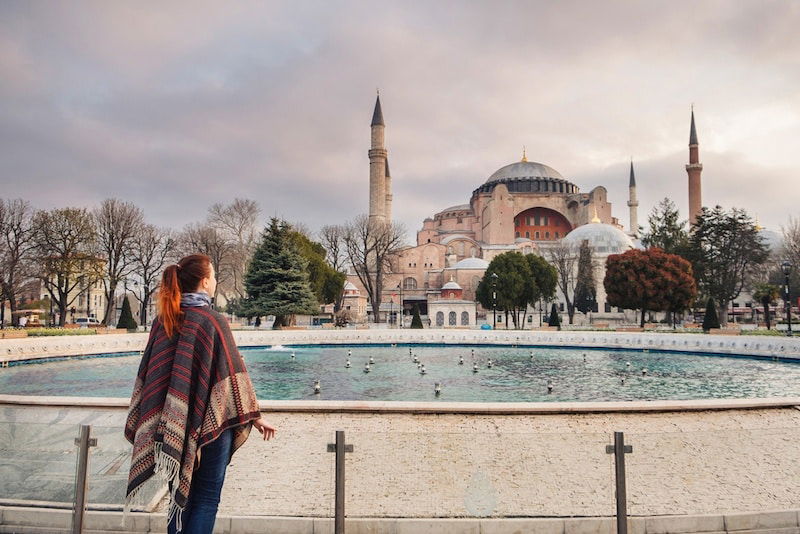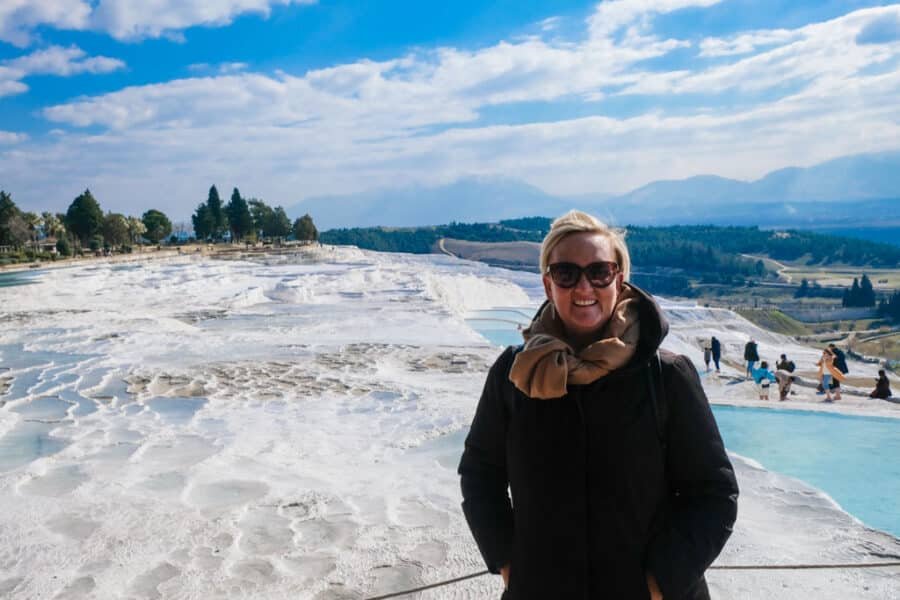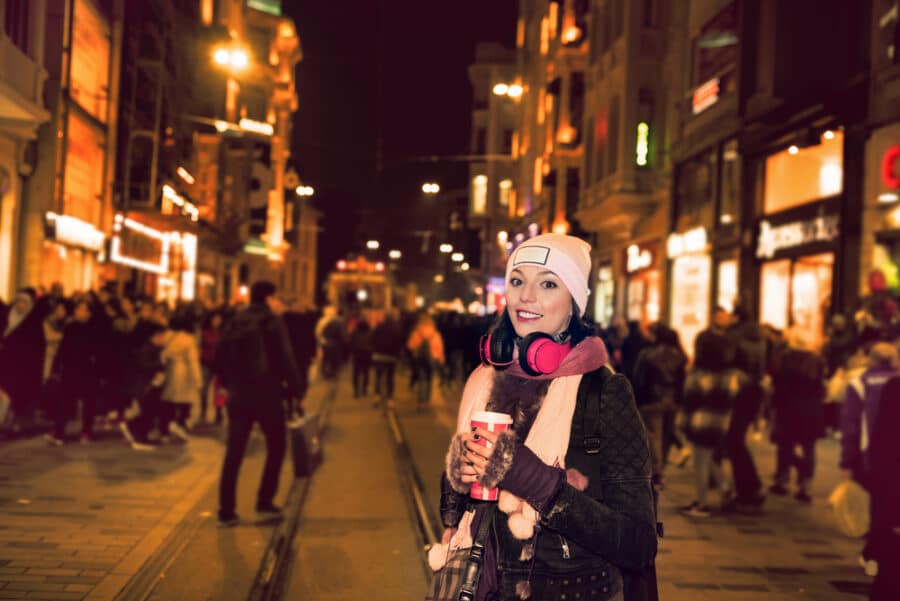Here is a guide on what to wear in Turkey. These Türkiye packing tips are listed area by area and are written by locals to ensure you know what you can (and can not ) wear in Turkey.

Türkiye is a vast country with cultural differences as you travel across and up and down. This dress code in Turkey for tourists guide will help you decide what to wear in Türkiye. We have you covered, from the Blue Mosque’s strict dress codes to beaches (see what we did there!?).
From the sun-drenched beaches of the south to the cosmopolitan Turkish cities in the northwest and west, into the more conservative towns and cities of the south, and the very traditional areas in the east and southeast. Turkey is a country that will show you a million different traditions and trends wherever you go.
However, one thing many people get wrong is the dress code in Türkiye, especially at religious stops.
There are no strict rules for what you should and shouldn’t wear in Turkey. That’s something we should point out here. Türkiye isn’t as conservative a country as places like Egypt, Saudi Arabia, Iran, or Pakistan.
While making your packing list for Turkey, it’s essential to know that the dress code in Türkiye is generally relaxed, and you can mostly wear whatever you wish. However, if you choose to wear whatever you please, you will find that you might find yourself attracting unwanted attention in certain areas where that choice isn’t in keeping with what the local people are used to.
So, while you won’t offend anyone, you might end up being stared at or whispered about, which will not make you feel exceptionally comfortable.
To further complicate matters, the general dress guidance varies depending on where you’ll travel in Turkey.
To help you avoid making faux pas and feeling out of place, let’s explore the main areas in detail, give you a few ideas of what to wear in Türkiye, and avoid over (or under) packing your bags.
First things first, mosque etiquette.
Skip Ahead To My Advice Here!
What To Wear When Visiting A Mosque Or Religious Sites

No matter where you are in Turkey, the rules for what to wear to a mosque are the same. Mosque dress code requirements are similar to those of other Muslim countries worldwide.
Be modest.
I am always asked, “Is there a Blue Mosque dress code”?
Yes, there are specific rules about what to wear to the Blue Mosque and all other mosques in Türkiye.
Pack Socks In Your Day Bag
Everyone must remove their shoes before entering the Blue Mosque, which means you must have some socks.
Consider A Shoe Bag
You’ll leave your shoes outside the mosque, and most mosques will have a place to leave them; it’s hard to say these will be safe or easy to get to when you go, especially at the prominent mosques in Istanbul during peak visiting times. If you’re in a rush or own expensive travel shoes, consider a shoe bag to place your shoes inside your backpack.
Wear Shoes That Come On And Off With Ease
You and the dozens of others will all be standing there trying to tie and untie shoelaces simultaneously. You’ll be glad if you choose to wear shoes that slip on and off easily.
Pack A Head Cover
Women need to cover their heads and hair and wear respectful clothing.
Many mosques offer head coverings you can borrow; however, if this isn’t something you prefer to use, you should pack your shawl or pashmina. One that is long enough to wrap around your head and cover your shoulders.
Think About What You Can Wear To Be Considered Modest
For Women to enter a mosque, they are not allowed to wear the following:
- Shorts
- Tank tops
- Vest tops
- Short skirts (a long skirt is suitable)
- Leggings
Wearing loose-fitting linen trousers or a long flowing dress or skirt is an excellent idea on the day you plan to go to the mosque.
The attendant on the door will inform you if they feel what you’re wearing isn’t appropriate and ask you to wrap a shawl around your midsection or over your shoulders if required.
Rather than borrow something dozens of other people will use that day, it’s far better to go prepared; I suggest you also consider wearing a long sleeve cotton shirt on that day.
For Men to enter the mosque, they are also required to wear respectful clothing. In this case, men should not be wearing:
- Vest tops
- Shorts
Men should wear long pants and a long-sleeved cotton shirt on this travel day. If the weather conditions are super hot, I have seen men get away with wearing a regular T-shirt.
Additional mosque etiquette: Be quiet and respectful when visiting a mosque. Do not walk in front of anyone praying, and never take pictures of people praying, either.
What To Wear Around Türkiye (Region Guide)

Deciding what to pack for Turkey is very simple, though you should know that the guidelines of what to wear in Türkiye are a little different, depending on where you plan on traveling. For example, in religious places like Hagia Sophia
What To Wear In Bodrum and at Turkey Beach Resorts

If you’re visiting a beach resort along the south coast of Türkiye, guidelines on what to wear are the same as anywhere else around Europe.
You’ll see people wearing bikinis on the beautiful beaches, and in some cases, you might even see topless sunbathing; however, this is certainly not encouraged. While no one will say anything to you about this, remember that Turkey is a conservative and Muslim country. Tank tops, shorts, flip flops, and other typical beachwear are all totally fine in the resort areas.
However, don’t go straight inside while wearing your swimsuit when heading into a bar or restaurant. Put on a coverup before entering.
You can wear whatever you wish when you go out at night. You may get stared at if you are dressed a little on the bare side, especially if you’re a woman.
However, for the most part, this part of Türkiye is far more laid-back, and in the famous holiday resorts, you won’t attract unwanted attention.
What To Wear In Istanbul And Izmir

Dress code for Izmir: While Istanbul and Izmir are pretty far apart in terms of distance, the two cities’ vibe is relatively similar. Izmir is a very cosmopolitan city, and it’s got quite a young feel. Therefore, you can wear your usual clothing; however, avoid anything too low-cut or too short.
Dress code for Istanbul: In Istanbul, the same rules apply; however, do remember that many parts of Istanbul are very historical, and that means you need to be a bit careful in terms of clothing.
The country is secular, so no clothing choices are forced on anyone. If you’re visiting Taksim, practically anything goes. However, if you’re visiting Sultanahmet, the city’s historic core, you should be respectful and avoid short skirts, shorts, tank tops, etc. Wearing slightly more modest clothing will also help prevent unwanted stares or attention.
What to wear in Türkiye summer: During the summer, sleeveless tops are fine, and you’ll see many tourists in shorts, but be mindful of the length – and how tight the shorts are. Cute maxi dresses are also acceptable during the summer season.
What To Wear In Central And Northern Turkey

If you’re venturing into central Türkiye, perhaps to Cappadocia or Ankara (the capital city), or to the north coast, you can wear almost anything again. However, you should know that this part of the country is slightly more conservative than the major cities and beach resorts we’ve covered so far.
- Women: Think of long-flowing dresses rather than booty-revealing denim shorts. Also, opt for a more modest dress or longer shorts than low-cut or short tank tops.
- Men: Nothing I can think of will offend the locals, so you’re good to go in your usual gear.
What To Wear In Eastern Turkey Or Southeast Turkey
Here is where you need to pay attention to what you pack. In particular, the southeastern part of Türkiye is very traditional, meaning you must dress very modestly.
- Men: You should wear jeans or long pants and T-shirts, and avoid vest tops
- Women: Please pack skirts and dresses that are below the knee and avoid wearing tank tops of any kind. T-shirts in the summer are generally okay, but it’s best to wear sleeves below the elbow. Cotton is your friend here; buy a flowing cotton shirt or a poly-cotton sundress to wear. A jumpsuit is also a great option – no need to be frumpy just because you are covering up a bit more!
Brands We Use And Trust
What To Wear In Turkey During The Evening
When visiting areas along the Turkish Riviera, Istanbul, and Izmir, you will notice that women tend to dress quite nicely for a night out – think dresses, blouses, jumpsuits, and heels. Men are often in more fitted shirts, trousers, and close-toed shoes.
Temperatures in the evening, especially along the coast, can dip. Bring a lightweight jacket if you feel chilly at 20 degrees Celsius.
What Shoes To Wear In Türkiye
The shoes you pack will all depend on your Turkey itinerary, as different temperatures occur from east to west.
A comfy pair of tennis shoes and a pair of socks are perfect for city breaks and mild hiking. Alternatively, consider hiking sandals, especially if you plan to hike in hotter regions of Turkey.
Pack a pair of dress shoes or heels for nights out, sandals for the beach, and flip-flops for wandering your hotel.
What To Wear In Türkiye In Summer, Winter & Beyond

- What to wear in Turkey summer: Summer means heat. Summer days get up to the ’30s (degrees Celcius), so you must pack loose, flowy dresses and loose-fitting pants. Try to pack nothing backless or with skinny shoulder straps.
- Packing for winter in Türkiye: Oh boy, it gets cold! Some days, it will only be 6 or 8 degrees, so you’ll want to pack a good down jacket, your wooly winter socks, travel boots, and a hat & gloves.
- Packing list for Turkey in September & fall tips: It starts warm and ends up freezing. Layers are your friend here, as is an excellent windproof jacket and scarf.
- How to dress in Türkiye in April and Spring: It starts cold in March, then is sunny and warm. Much like fall, it’s a good idea to pack in layers, things that can be interchanged quickly. You know, like tights for under your long dress and an anorak that goes with jeans and shorts.
Wearing A Head Covering In Turkey
You don’t have to cover your head.
You’ll find an equal split of women in Türkiye covering their heads versus those who do not. That means you’ll be good to walk down the street in your regular clothes (modestly chosen) without your head covered, and you won’t encounter any issues. It’s a personal choice here and not a necessity.
Though you’ll need something to cover your shoulders, why not pack one that can also flip up over your head?
As you can see, there are no significant rules regarding what to wear and what not to wear in Turkey – think modestly.
What Else To Pack For Türkiye

Now that we’ve answered what appropriate clothes to pack for Turkey, here are some other items you should remember to add to your Türkiye packing list all year round:
- Sunglasses. Think of those wrinkles
- Hat. A blazing sun is glorious on vacay; a red face is not so much
- Sunscreen. Packaging your own is a good idea, or you risk buying overpriced options available at tourist sites.
- Cross-body bag. This is particularly handy at the Grand Bazaar in Istanbul, where pickpockets seek out tourists during peak periods.
- Anti-theft bag. If you want to be extra safe, a slash-proof bag with other anti-theft features is a great idea.
- Toilet paper. It seems strange, but trust me when I say that traveling through Turkey can mean finding a small hose instead of loo paper. Of course, tourists have toilet paper in touristy places, but who wants to get there only to find an empty cardboard roll?
- Travel Umbrella. Pack a small and light one to be safe
- Portable charger power bank. Türkiye is so large you will find yourself in transport often, and there’s nothing worse than losing all your power throughout the day before you can recharge
- European Travel Plug Adapter with USB Ports.
Packing Lists By Season

- 4-5 T-shirts (shoulder covering if possible)
- 2-3 long-sleeved shirts
- Two pairs of shorts (consider slightly longer versions if possible)
- Two pairs of lightweight pants
- Bathing suit and beach coverup
- Two long dresses or jumpsuits for nights out
- Foldable sunhat
- Walking shoes, beach shoes, dress shoes
- Head scarf (or buy one at the markets in Turkey)
- Intimates
- Rain jacket/umbrella
- 4-5 T-shirts
- 3-4 long-sleeved shirts (you will use some for nights out)
- Two pairs of shorts (knee length if possible)
- Two pairs of lightweight pants
- Swimsuit
- One pair of dress pants for nights out
- Foldable sunhat
- Walking shoes, beach shoes, dress shoes
- Intimates
- Rain jacket/umbrella
- 4-5 long-sleeved shirts (at least one should be a sweater)
- Two pairs of pants (one should be dedicated for hiking & outdoors)
- 2-3 skirts with leggings (or additional pairs of pants if skirts aren’t your thing)
- Head scarf (or buy one at the markets in Türkiye)
- Comfortable boots/flats/walking shoes and a good pair of hiking shoes
- Long underwear/thermals if planning lots of outdoor time
- Intimates
- Rain jacket/umbrella
- Winter coat, mittens, hat, scarf
Weather Forecast In Türkiye

Turkey’s diverse geography leads to significant variations in weather across the country, offering travelers an array of climates and experiences. Along the stunning coastal regions like Antalya, the Mediterranean climate ensures hot, dry summers, while further inland, cities like Istanbul experience milder maritime conditions.
In the southwestern destinations of Marmaris and Fethiye, Mediterranean influences create distinct weather patterns compared to central Türkiye.
Venturing inland towards Cappadocia, the climate becomes more continental, marked by cold winters and warm summers, with unique terrain featuring fairy chimneys and cave dwellings. Along the western coast, vibrant cities like Izmir and the charming town of Alacati enjoy milder temperates and weather.
These regional variations are due to Turkey’s vast landscape, which includes coastal regions, mountainous terrains, and interior plateaus.
These climatic disparities cater to a wide range of preferences, whether you seek the sunny beaches of the Mediterranean, the cultural richness of Istanbul, or the surreal landscapes of Cappadocia. Türkiye’s distinct climates make it a year-round destination, ensuring there’s always a perfect place to explore regardless of the season.
Istanbul
Spring
Spring in Istanbul is mild and pleasant. Temperatures gradually warm up, with daytime highs ranging from 12°C to 20°C (54°F to 68°F). Rainfall is moderate.
Summer
Istanbul summers are warm and can be humid. Daytime temperatures vary from 24°C to 30°C (75°F to 86°F). It’s the driest season with minimal rainfall.
Autumn
Autumn is characterized by mild to cool temperatures. Daytime highs range from 18°C to 25°C (64°F to 77°F). Rainfall increases gradually.
Winter
Winters in Istanbul are cold and damp. Daytime temperatures average between 6°C to 10°C (43°F to 50°F), and it can be pretty rainy.
Izmir (Including Alacati)
Spring
Spring in Izmir is pleasant, with daytime temperatures between 14°C to 21°C (57°F to 70°F). Rainfall is moderate.
Summer
Summers are hot and dry in Izmir, with daytime highs ranging from 28°C to 34°C (82°F to 93°F).
Autumn
Autumn brings milder temperatures, with daytime highs between 20°C to 28°C (68°F to 82°F).
Winter
Winters are cool and somewhat wet, with daytime temperatures averaging 10°C to 15°C (50°F to 59°F).
Antalya
Spring
Antalya experiences a pleasant spring with daytime temperatures between 15°C to 25°C (59°F to 77°F). Rainfall is moderate.
Summer
Summers are hot and dry, with daytime highs ranging from 28°C to 35°C (82°F to 95°F).
Autumn
Autumn is warm, with daytime temperatures between 20°C to 30°C (68°F to 86°F).
Winter
Winters are mild and relatively wet, with daytime temperatures around 12°C to 18°C (54°F to 64°F).
Cappadocia
Spring
Spring in Cappadocia is cool, with daytime temperatures between 10°C to 20°C (50°F to 68°F). It can be rainy.
Summer
Summers are warm, with daytime highs ranging from 25°C to 30°C (77°F to 86°F).
Autumn
Autumn is cooler, with daytime temperatures between 15°C to 25°C (59°F to 77°F). It’s a great time to visit with fewer tourists.
Winter
Winters are cold, often dropping below freezing, with daytime temperatures of 0°C to 10°C (32°F to 50°F). It can be snowy, creating a picturesque landscape.
- 4-5 long-sleeved shirts (at least one should be a sweater)
- Two pairs of pants (one should be dedicated for hiking & outdoors)
- 2-3 pairs of dress pants
- Comfortable boots/walking shoes and a good pair of hiking shoes
- Long underwear/thermals if planning lots of outdoor time
- Intimates
- Rain jacket/umbrella
- Winter coat, mittens, hat, scarf
What should female tourists wear in Turkey?
Avoid wearing tank tops, short shorts, and short skirts. It’s best to dress modestly to avoid unwanted attention.
Does Türkiye have a dress code?
No – Turkey is much less conservative than neighboring countries. There is no dress code; however, dressing modestly is still advised to respect the local culture.
Can I wear a bikini to the beach in Türkiye?
Absolutely. The dress attire in beach resorts and along the Turkish Riviera is similar to any other beach destination – shorts, tank tops, swimsuits, flip flops, bikinis, etc.
Can I wear shorts in Turkey?
In beach resort areas, shorts are completely fine. Consider wearing longer shorts or jeans when exploring other cities like Cappadocia, Ankara, and Istanbul. Blue and black jeans are actually a popular staple in Istanbul.
Do I need a jacket in Türkiye?
Even in the summer months, the evenings can get cool in Turkey. Having a light jacket or sweater is a good choice.
Do I need to cover my shoulders in Turkey?
You don’t have to cover your shoulders unless you are entering a mosque.
What is the appropriate dress code for visiting religious sites in Türkiye?
When visiting mosques or other religious sites, it’s essential to dress modestly. Women should cover their heads, shoulders, and legs, while men should avoid sleeveless shirts and shorts.
What should I wear in coastal areas and beach destinations?
In coastal areas like Istanbul, Antalya, and Bodrum, casual summer clothing like t-shirts, shorts, dresses, and swimsuits are appropriate, especially during the warm months.
Is it necessary to bring warm clothing for my trip to Turkey?
If you plan to visit Türkiye during the cooler months or in regions with colder climates, it’s advisable to bring some warm clothing, including a jacket, scarf, and layers.
What footwear should I bring for exploring Turkey?
Comfortable walking shoes or sandals are recommended for exploring Türkiye, as you might be walking on uneven terrain in historical sites or markets.
Are there any specific clothing tips for women traveling to Turkey?
Women can wear a variety of clothing in Türkiye, but it’s advisable to respect local customs in conservative areas by covering shoulders and legs.
Can I wear tank tops and shorts in urban areas like Istanbul?
Yes, wearing shorts and a tank or crop tops are acceptable in urban areas like Istanbul. However, dressing slightly conservatively when visiting religious or traditional neighborhoods is a good idea.
Should I bring a swimsuit for my trip to Turkey?
Yes, if you plan to visit coastal areas or enjoy the beaches, bringing a swimsuit is recommended.
So long as you are mindful of traditions in the particular areas mentioned and dress modestly, packing your bags for Türkiye will be easy!
- Food You HAVE To Try In Türkiye
- The Do’s And Don’ts Of Visiting Turkey
- Best Places To Visit In Türkiye For Every Type Of Traveler
- How To Get From Istanbul To Cappadocia
- Should You Visit Southeastern Turkey
- Cappadocia Hot Air Balloons
- The Best Nightlife In Istanbul
- Day Trips To Take From Istanbul
- Packing Webstory
- Tips For Visiting Gobekli Tepe Archaeological Site
- Best Packing Cubes For Travel



I live in Adana and I see many, most younger Turkish women (under 30) wearing tank tops, short shorts, short skirts, and skin tight pants. I saw the same in Gazientep and to a smaller degree Sanliurfa. I didn’t wear shorts and tee shirts out until I saw locals wearing them my first day. Beach towns/resorts in summer are definitely not conservative. Yes being respectful of local customs and clothing is appropriate, but wearing skirts and dresses is definitely not required.
Very interesting and informative! The dress code is always one of the things to check before traveling to a destination, Especially in lesser-known destinations. Have you ever been to Iran? I hope you do soon and post about how great it is.
This was spot on! And so helpfuil.
Hi great posts.
Can you tell me how is Turkey in November (first 14 days), largely Alacati, Marmaris , Fethiye, Antalya, Cappadocia and Istanbul
Turkey experiences varying weather conditions in November, with differences in climate and temperature depending on the region you plan to visit. Alacati, on the western coast near Izmir, begins to transition from warm summer weather to cooler autumn temperatures. Expect daytime temperatures between 15°C to 20°C (59°F to 68°F). Marmaris and Fethiye, both on the southwestern coast, see a decline in tourism during November with daytime temperatures ranging from 15°C to 20°C (59°F to 68°F) and the possibility of occasional showers.
Antalya, known for its mild Mediterranean climate, has daytime temperatures typically between 18°C to 23°C (64°F to 73°F) in November. It’s generally sunny but can have some rainy days. In Cappadocia, located in central Turkey, November brings cooler temperatures with daytime highs of 10°C to 15°C (50°F to 59°F) and colder nights, often dropping below freezing. This is an excellent time to visit with fewer tourists but prepare for cold weather.
Istanbul, in November, tends to be chilly and damp with daytime temperatures around 12°C to 15°C (54°F to 59°F). Rain is relatively common, so waterproof clothing is advisable. While less crowded than in the summer, Istanbul remains vibrant and culturally rich.
Have a great time!!